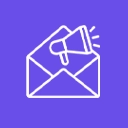Knowing how to send personalized sales emails is already a differentiator that captivates the recipient. And the best sales strategies are linked to personalization.
According to data from Accenture, 91% of consumers tend to buy from brands that offer recommendations that are relevant to them.
This means that understanding the best way to send emails that speak directly to the recipient leads to more sales.
In other words, it all starts with personalization, which is nothing more than an effort to build relationships.
You can see that personalization comes first and then sales, right?
And acquiring an exclusive domain is the first step in getting your leads to listen to what you have to say through personalized emails.
That’s because the content you share with your audience is the key to creating a connection. And for that to happen, credibility is fundamental.
Next, we’ll look at how to personalize your communication with the aim of qualifying the lead for a sale.

Table of contents
How to send unique and captivating sales emails
Ehere are a number of elements to creating personalized emails, bearing in mind that customization is not just about including the recipient’s name in the subject line.
Personalization requires audience segmentation, which allows professionals to get to know their leads’ buying habits and behaviours better.
This makes it possible for the emails sent to respond to consumers’ needs, signalling that your content is customized in the right way. In other words, segmentation makes your message able to talk directly to your audience.
But there is one detail that can hinder the success of your communication with the customer: invalid emails in your contact list.
Read on to find out more about how an email becomes invalid.
What are invalid emails
You’ve built your contact list, but there are a lot of emails with typos, or that have been abandoned for more than 3 months, or that are disposable (they expire after a period of time and become non-existent).
All of these contacts, among other types of bad emails, are considered invalid, since it is not possible for you to communicate with them.
Email verification removes all invalid emails, risky emails and bounces (messages that could not be delivered for various reasons) from the lists.
In this way, the bases are cleaned, containing only emails that are suitable for receiving communications, and therefore valid.
Now, with a clean contact base, we can talk about how to send personalized emails!
How to personalize communication
An sales email (and other pieces of communication) can be personalized in many ways. But for this to happen, you need to know your audience. See the steps below for the safest ways to do this.
Segmentation: use an automation platform to organize your leads according to their priorities, buying behaviour, geographical location, age and any other data that makes sense for your marketing strategy.
Carry out A/B tests: find out what your lead’s preferences are and create content that connects with them. Test everything from text arguments to the colors and formats of the visual elements in your emails. This is what will bring your communication closer to the consumer’s needs.
Create your persona: both audience segmentation and A/B testing will serve as filters to create the ideal representation of your customer, revealing their mindset, desires and pains. From there, you can link your product/service to a solution.
Monitor KPIs: keep an eye on the results of your campaigns. This is where the persona’s receptiveness will be confirmed. Based on the performance of the campaigns, you can improve your content to promote even more connection and proximity with the recipients.
How to send sales emails
Sales will only happen when the lead reaches the bottom of the funnel. This means that the persona must go through all the stages of the buyer’s journey, receiving nurturing content.
To nurture the lead who is receiving personalized communications, the suggestion is to create a flowchart of personalized emails through a direct marketing campaign.
Sales emails can be:
- 100% digital – product/service and price, with CTA leading to the checkout page.
- Consultative, with a product/service and the presence of a consultant, whose role is to help leads by clarifying doubts and presenting solutions.
Consultative sales emails are more humanized, but that doesn’t mean they are the most appropriate for your persona.
That’s why it’s so important to know the consumer’s behavioral characteristics. It is they who will decide which channel is most suitable for receiving the information they need.

How to send personalized emails that sell: conclusion
Is it possible to make sales without personalization? Yes, but the results will be much lower than if there is an effort to get to know the persona and their needs.
In this way, personalization boosts sales by providing a more complete piece of work, which can even be used to create a lasting relationship with the lead.
FAQ
Why is personalization so important for sales strategies?
Personalization has been created so that the public can identify with the communication. And bringing the lead closer to the product/service favors the decision to buy. This facilitates the work of sales teams, who spend less effort persuading leads.
What are the ways to personalize communication with leads?
Segmentation is the first step in organizing leads according to elements that identify them in groups. Once they have been identified, A/B tests are crucial to getting to know the consumer’s behavior in depth, with their preferences and buying habits. From there, the persona can be created, representing the customer and their pains. After all these stages, KPIs should be monitored to find out what had an effect and what didn’t, so that communication can be improved.
What are the types of sales emails?
Sales emails can be entirely digital, with a product, price and checkout page, or consultative, with the presence of a sales professional to help the lead find solutions.



